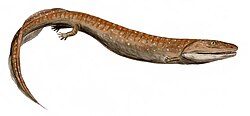| Koharalepis Temporal range: Middle Devonian | |
|---|---|
| Scientific classification | |
| Domain: | Eukaryota |
| Kingdom: | Animalia |
| Phylum: | Chordata |
| Clade: | Sarcopterygii |
| Clade: | Tetrapodomorpha |
| Family: | † Canowindridae |
| Genus: | † Koharalepis Young & Ritchie, 1992 |
| Species: | †K. jarviki |
| Binomial name | |
| †Koharalepis jarviki Young & Ritchie, 1992 | |
Koharalepis is an extinct genus of canowindrid tetrapodomorphs which lived in what is now Antarctica during the Middle Devonian. It contains one species, K. jarviki. [1]





